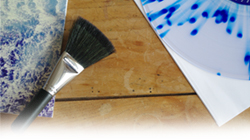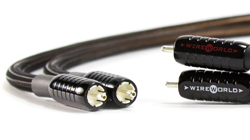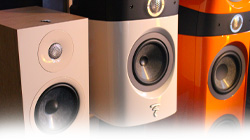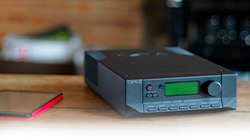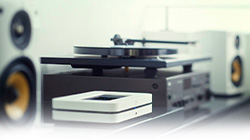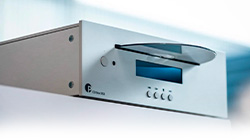
5. Motor and drive
The motor technology used by manufacturers to build their turntable is determined by its drive principle.
a) Direct current motors
Their speed of rotation is determined by the direct current that is associated with them. It is controlled by an electronic circuit that, via sensors on the platter, controls the rotation with maximum accuracy and allows switching between 33 rpm, 45 rpm and even 78 rpm. This solution is used with belt-driven and direct drive turntables.
b) Alternating current - a.k.a. synchronous - motors (with hysteresis)
Their speed of rotation is dependent upon the frequency delivered by the mains power grid, so in France by ERDF, or 50 Hz in Europe (60 Hz in Canada and the USA). Theoretically, they are not affected by voltage variations. As they are easy to equalise, they are quite silent and generate little vibration, in particular for next-generation models with a 24 V (REGA P3/24) or 16 V (ENTIRE PRO-JECT RANGE, THORENS, etc.) power supply.
Furthermore, these motors are seldom coupled to the plinth: they are either attached with vibration isolation bushings, or suspended via a rubber belt (PRO-JECT Xpression). Some manufacturers even place them externally to the turntable, thereby eliminating any mechanical connection with it (CLEAR AUDIO, VPI, PRO-JECT RPM 9.2 and 10). In the absence of a variable frequency power supply unit, very often optional (PRO-JECT SPEED BOX, REGA TT PSU), playback speed is changed manually, by moving the belt on the drive pulley flanges. The largest diameter is for 45 rpm records and the smallest for 33 rpm records.
The choice of drive system is chiefly related to the use of the turntable rather than strictly quality-oriented considerations:
>> Belt drive
It has the advantage of moving a minimum number of parts. A belt is fitted around the motor spindle and sub platter supporting the platter. This design is extremely simple and has been well tried (PRO-JECT DEBUT3, REGA RP1, REGA PLANAR, THORENS 309…). The advantage of this drive system is that it is cheap and generates very little vibration, and therefore very low background noise on playback. However, start-up time is quite long and may give rise to slight fluctuations due to the belt's elasticity (compression/expansion). This defect has been mitigated in recent years with the use of synthetic materials for the belt design (REGA PERFORMANCE PACK).
>> Idler drive
On turntables designed in the late 1950's, chiefly for radio broadcasting, the drive system used a metal wheel with a rubber edge coupled to the inner edge of the platter. The wheel was driven by a stepped pulley to prevent speed variations. A lever was used to engage the wheel, to start the rotation very quickly. This solution required very fine machining of all the mechanical parts to keep the noise level to a minimum and keep the speed linear (THORENS TD 124).
>> Direct drive
It is chiefly used on DJ turntables, the most famous one is the Technics SL1200 Mk2. The platter spindle is in fact the motor spindle. The motor needs a significant torque at start-up. It must be perfectly balanced and its bearings and spindle must be of excellent quality and requires high precision machining to prevent friction and noise that could affect the platter. This principle also requires precise electronic control (via a quartz dial) to stabilise the speed and format changes (33 rpm, 45 rpm). All these elements guarantee extremely short start-up times, easy synchronisation for sequences and the possibility, via a specific forward/backward playback cartridge, to produce sound effects (scratching). We can say that the DJ turntable is the cornerstone of Rap music.
6. Tonearm
This part requires highly accurate machining and assembly. It plays a pivotal role as it guides the cartridge with as little stress as possible inside the record's groove yet with enough precision and stiffness to allow the stylus to perfectly trace the groove walls, both vertically and horizontally.
There are several types of tonearm, with various shapes and lengths, in various materials. The most commonly used nowadays in the Hi-Fi industry is the linear tonearm, but there are also tonearms with an S-shaped or bent profile, chiefly used on DJ turntables.
The tonearm must rotate along two axes (horizontal and vertical) with minimum stress, and therefore as little friction as possible. To this end, miniature ball bearings are inserted inside the axles to allow for rotation. There are also pivots mounted on a needle or a knife bearing (SME). Many high end tonearm models are called 'UNIPIVOT' tonearms (VPI). Their axle rests on a single tip. The most sophisticated models are linear tracking tonearms (CLEAR AUDIO STATEMENT), rarely used in mainstream products because they are very complex to make and adjust and very expensive to produce.
To meet the various playback-related constraints, the tonearm must be lightweight and be sufficiently stiff and, like every mechanisms related to acoustics, it must not resonate (at least the resonance frequency must be outside the audible spectrum, i.e. very low). This is why tonearms are made of steel, aluminium (PRO-JECT DEBUT3), stainless steel, wood and bone. In recent years, composite materials with outstanding mechanical properties have appeared. CARBON is the most widespread, and it ideally suits the purpose: lighter than aluminium and stiffer than steel, it is characterised by a very low resonance frequency and has good conductive properties, making for efficient shielding for the cables running through it (PRO-JECT 9C, 10 C, WILSON BENESCH ACT…).
The tonearm can include a manual tonearm lifter. On AUTOMATIC TURNTABLES, the tonearm automatically lifts at the end of the record via a mechanical device.
Some tonearms are fitted with a detachable headshell. It is not integral with the tube. Its role is in fact essential as it is the main mechanical and electrical link between the cartridge and the tonearm. They are available in various materials: alu, wood, carbon (ORTOFON, FURUTECH, OYAIDE).
For optimum performance, a tonearm must be perfectly adjusted. Adjustment is an integral part of the turntable and the associated cartridge. Not all tonearms are compatible with all turntable and cartridge models! Several parameters will affect cartridge and tonearm compatibility.
a) Height
The height of tonearms designed by specialist manufacturers is adjustable by moving the column holder in the base that supports it on the turntable. This adjustment is essential because, contrary to common preconceptions, no cartridge has the same profile and, therefore, the same height. Insofar as it is necessary for the stylus to track the record groove at a 45° approach angle, it is essential to adjust the tonearm height so that the face of the cartridge forms a straight angle with the surface of the record. Some tonearms without this adjustment (REGA) can only accommodate the cartridges recommended by the manufacturer, unless 1.2 or 4 mm thick spacers are fitted between the tonearm holder and the turntable base. Manufacturers deliver the spacers either as standard or optionally.
b) Tracking force
Directly dictated by the manufacturer's data of the cartridge, it is expressed in grams or newtons. It is traditionally between 1.5 g and 3.2 g. Generally, mid-range MM cartridges require a tracking force of 1.75 g, and 2.2 g for MC cartridges. There are however other cartridges on the market that require a tracking force above 3 g. After setting up and aligning the cartridge, it is necessary to 'tare' the tonearm. By rotating the counterweight behind it, the aim is to obtain the perfect balance, known as the zero balance. This operation must be performed with the ANTISKATING setting Off. Then the recommended tracking force is added. Contrary to what you might think, a tonearm that is too light could have more negative effects than if it is too heavy, because when the record rotates, it leads to loss of contact between the stylus and the groove and oscillation on the walls, which directly affects the wear of the diamond (STYLUS) and of the surface of the record. On some turntables, the tracking force can be applied by a calibrated spring, adjustable via a graduated thumb wheel (LINN).
c) Centripetal force correction
Identified as 'ANTISKATING' on turntables, this setting overcomes the lateral thrust applied to the tonearm when the stylus is inside the groove with the record spinning. This force draws the tonearm to the centre of the microgroove and must be compensated to prevent wear on the inner wall of the record and Stylus. Manufacturers have developed a number of systems. The most widespread and the simplest in design (yet well tried) involves hooking up a small weight using a very thin nylon thread to a graduated rod parallel to the tonearm tube, at the back of the pivot, and to allow it to catch onto a small rod to the left of it (THORENS, PRO-JECT). Some manufacturers use a magnetic repulsion system (CLEAR AUDIO), others a coiled spring system that can be adjusted with a thumb wheel. Some unipivot tonearm models are completely devoid of them (VPI, NAIM AUDIO, WELL TEMPERED).
7. Belt
In 95 % of cases, it is made of rubber, though it can vary in length and profile. It can have a flat and wide (THORENS, PRO-JECT DEBUT…), square (PRO-JECT RPM9 and 10) or round (REGA, VPI, PRO-JECT RP1) section. Some are made of a polyester thread (WELL TEMPERED). Their length and elasticity have an influence on the listening quality as they imply more or less noise and vibration, and therefore WOW. An OEM belt must always be used.
8. Clamp or puck
To keep the record perfectly level and guarantee that it adheres to the turntable platter as much as possible, clamps can be used. Clamps are definitely not to be used with suspended turntables because their weight would crush the suspension and offset it. However, for rigid turntables intended for this purpose, clamps significantly improve precision and dynamic range (PRO-JECT RPM 9 and 10, XTENSION…). Some clamps are fairly lightweight, but they compensate for the weight by bonding to the record by screwing onto the platter's central spindle (VPI, PRO-JECT 2 XPERIENCE).
![How do I choose a turntable ?]() How do I choose a turntable ? Discover
How do I choose a turntable ? Discover![How do I take care of my records?]() How do I take care of my records? Discover
How do I take care of my records? Discover![The different types of Hi-Fi cables and their role]() The different types of Hi-Fi cables and their role Discover
The different types of Hi-Fi cables and their role Discover![How to choose your Hi-Fi speakers?]() How to choose your Hi-Fi speakers? Discover
How to choose your Hi-Fi speakers? Discover![How do you choose the amplifier?]() How do you choose the amplifier? Discover
How do you choose the amplifier? Discover![How do you choose your dematerialized equipment?]() How do you choose your dematerialized equipment? Discover
How do you choose your dematerialized equipment? Discover![How to place your Hi-Fi devices?]() How to place your Hi-Fi devices? Discover
How to place your Hi-Fi devices? Discover![How to build a complete Hi-Fi system?]() How to build a complete Hi-Fi system? Discover
How to build a complete Hi-Fi system? Discover



